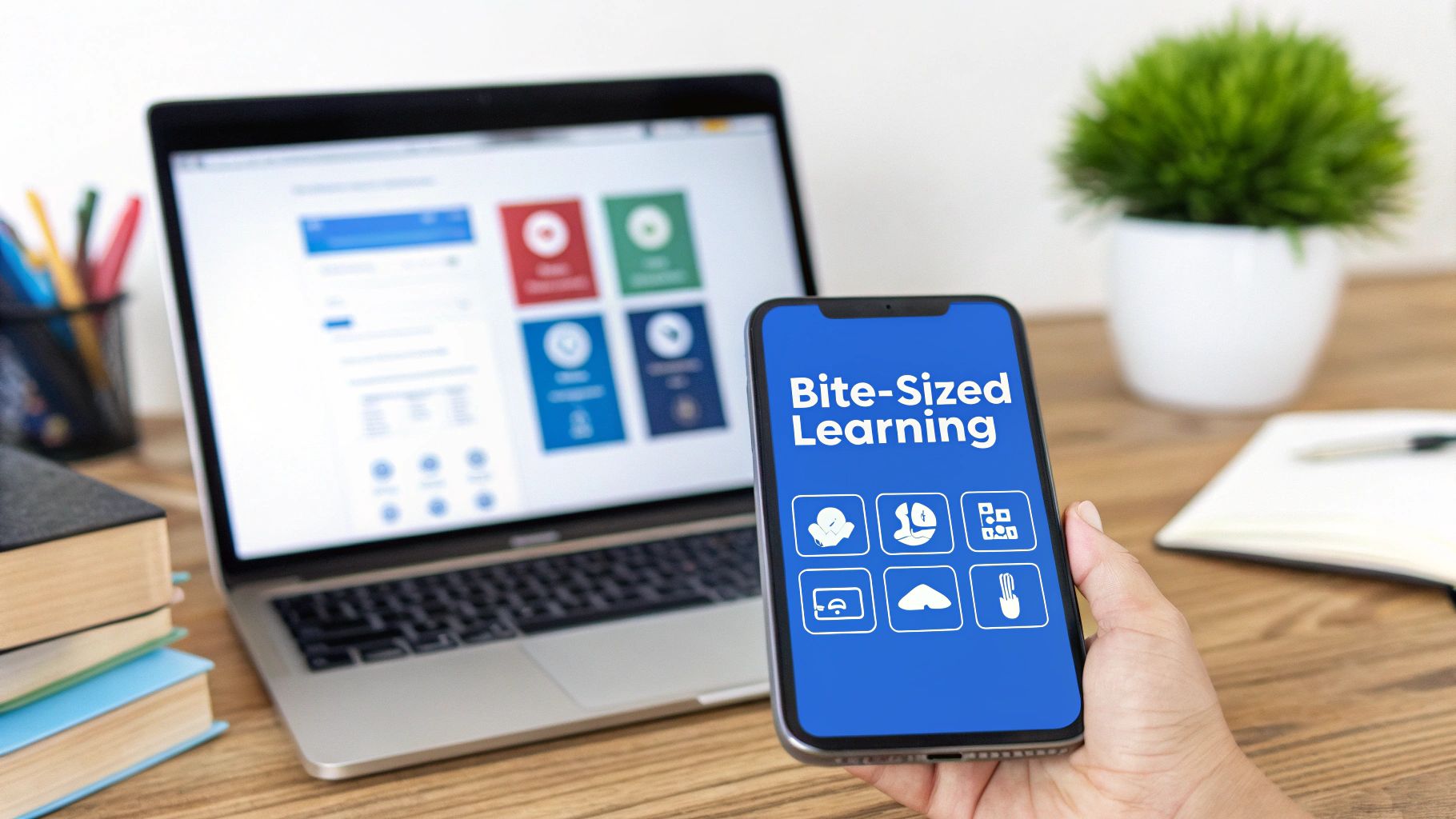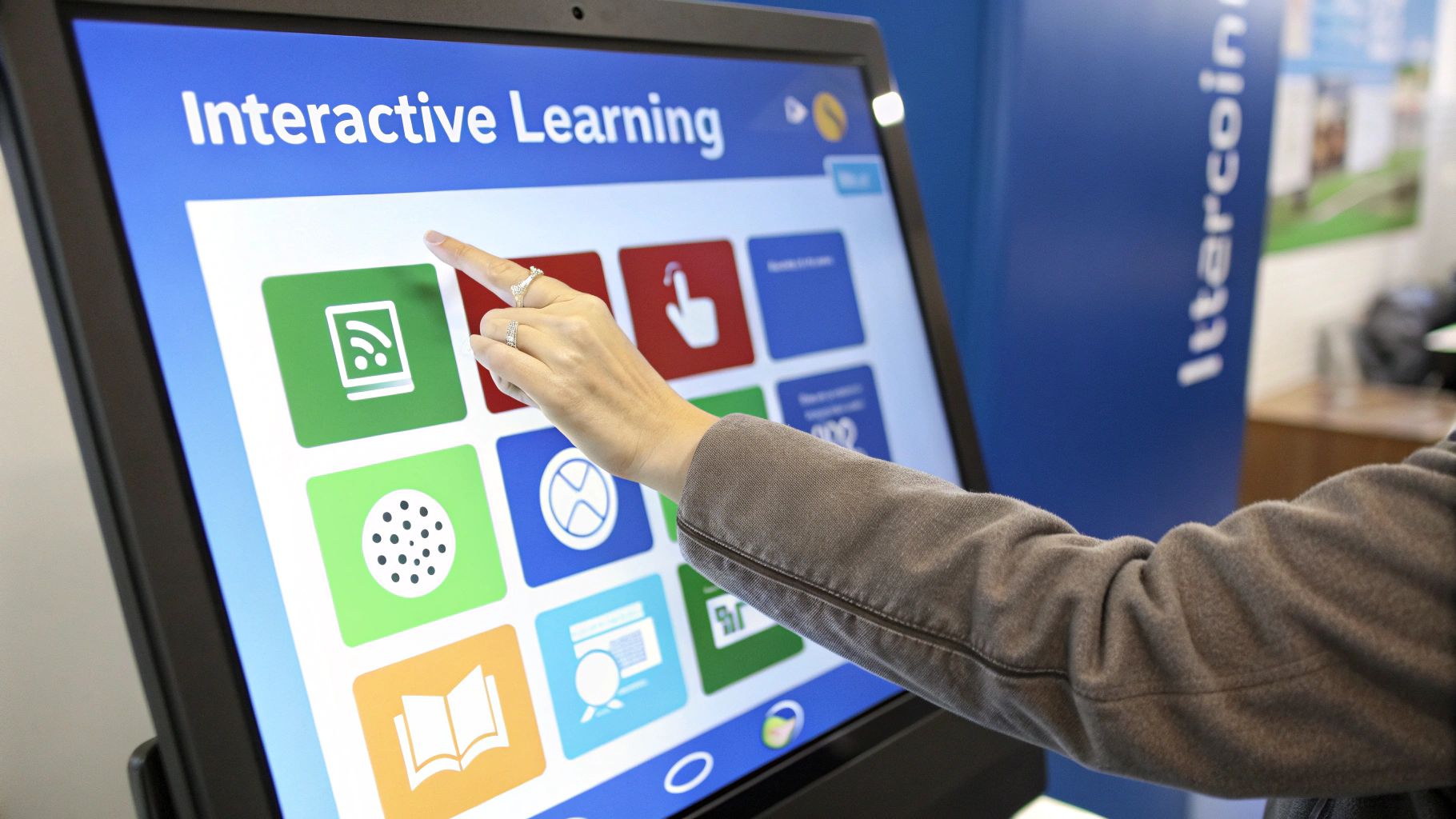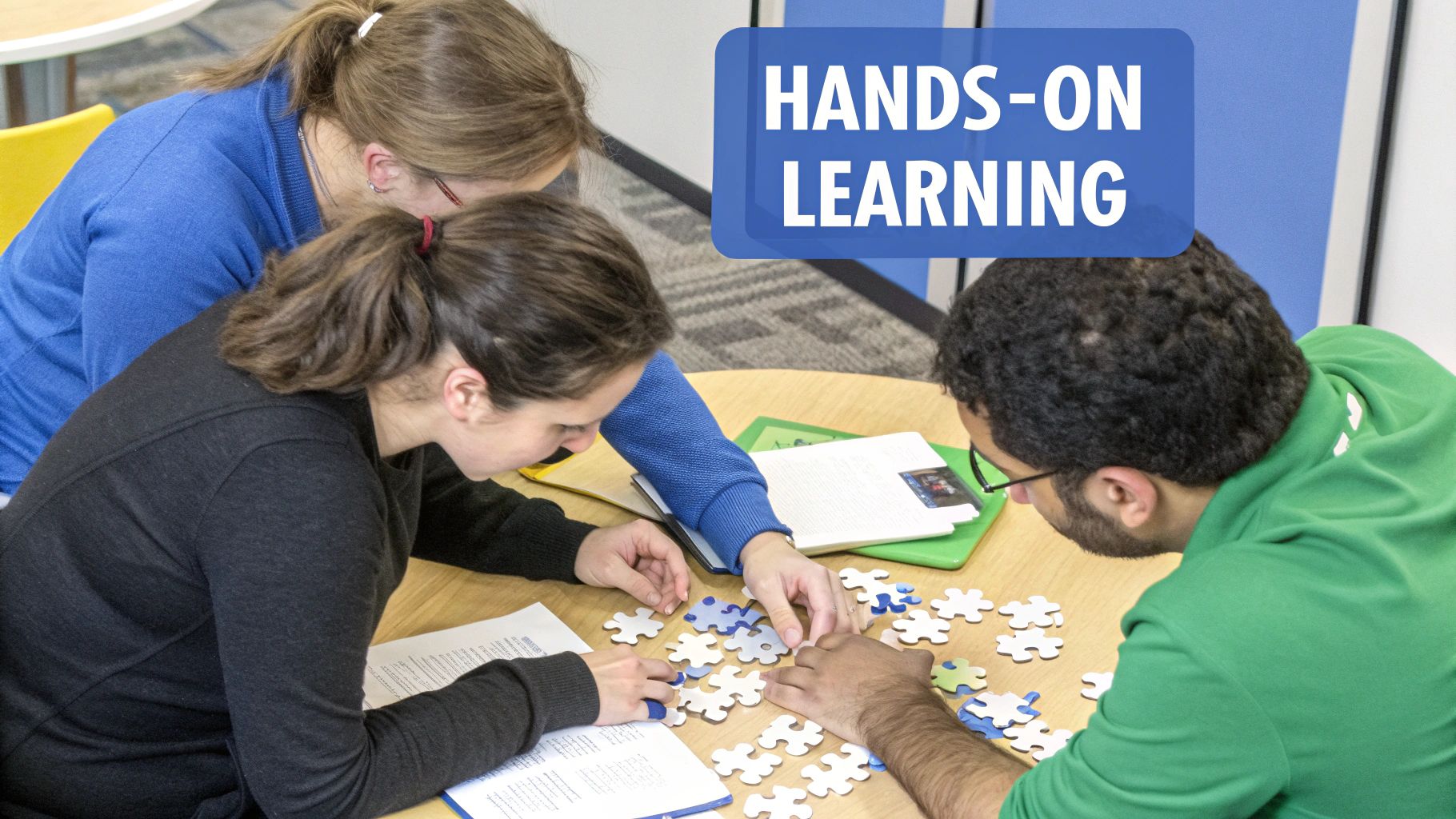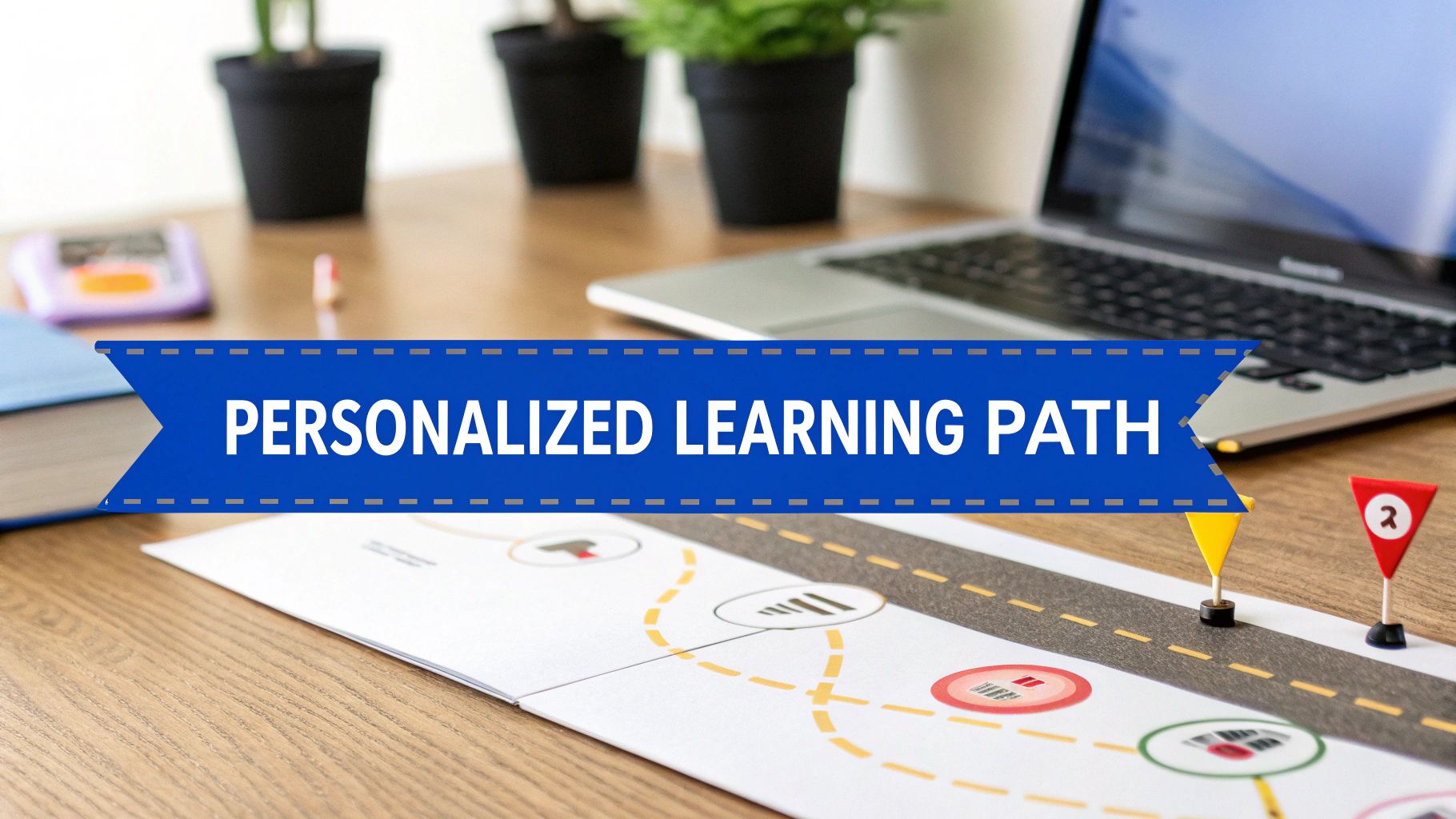
Discover 9 online learning best practices to boost engagement and results. Explore actionable tips on interactive video, feedback, and personalization.
The shift to digital education is complete, but simply moving content online is not enough. True success in the digital classroom, whether for corporate training, B2B marketing, or higher education, hinges on deliberate design and strategic execution. Standard, passive learning models often lead to disengagement and poor knowledge retention, failing to deliver on their promise.
This guide moves past the obvious to detail proven online learning best practices that drive meaningful engagement and measurable outcomes. We will explore specific, actionable strategies designed to transform passive viewers into active participants. You will learn how to structure content using microlearning, integrate dynamic multimedia, and build personalized learning paths that cater to individual needs.
These techniques are critical for creating effective and inclusive learning environments. Prepare to elevate your online courses from simple content delivery to transformative educational experiences that capture attention, boost comprehension, and deliver tangible results for your audience, from sales prospects to new employees.
1. Microlearning and Chunking
One of the most effective online learning best practices is structuring content using microlearning and chunking. This approach involves breaking down extensive, complex topics into small, highly-focused learning segments. Instead of a single hour-long lecture, learners engage with a series of 5 to 15-minute lessons, each designed to achieve a specific, narrow learning objective. This method directly addresses cognitive load theory, which suggests our working memory can only process a limited amount of new information at once.

This strategy is powerful because it respects the modern learner's busy schedule and limited attention span. By delivering content in bite-sized pieces, you make it more digestible, less intimidating, and easier to retain. A prime example is Duolingo, which has mastered this with its 3-5 minute language lessons that users can complete on the go. Similarly, platforms like Khan Academy and LinkedIn Learning offer short, skill-specific videos that allow professionals to quickly upskill without committing to a lengthy course.
How to Implement Microlearning
- Define Clear Objectives: Start by setting a single, clear learning goal for each micro-lesson. What is the one key takeaway a learner should have after completing the module?
- Create Logical Pathways: While each micro-lesson should be able to stand alone, ensure they connect logically to form a cohesive, comprehensive learning journey. Guide learners from one chunk to the next.
- Incorporate Quick Knowledge Checks: End each segment with a short quiz, a single reflective question, or a simple interactive element to reinforce the concept and confirm understanding.
- Vary Content Formats: Use a mix of short videos, infographics, quick readings, and interactive simulations to keep the experience engaging across different micro-modules.
2. Interactive and Multimedia Learning
Another essential component of effective online learning best practices is the integration of interactive and multimedia elements. This approach moves beyond static text and passive video lectures by incorporating diverse media types like animations, simulations, and hands-on exercises. By engaging multiple senses and catering to different learning modalities, you transform content consumption into an active, participatory experience. This aligns with Richard Mayer's Cognitive Theory of Multimedia Learning, which posits that learners process information more deeply when it is presented in both words and pictures.

This strategy significantly boosts engagement and knowledge retention by making abstract concepts tangible. For instance, Labster provides virtual science laboratory simulations that allow students to conduct experiments that would be too dangerous or expensive in real life. Similarly, companies use tools like Articulate Storyline to build branching scenarios that let employees practice customer service skills in a risk-free environment. Coursera enhances its video lectures with interactive transcripts and in-video questions, ensuring learners are actively processing the information rather than just watching passively.
How to Implement Interactive and Multimedia Learning
- Align Media with Objectives: Select multimedia elements that directly support your learning goals. Use an animation to illustrate a complex process, a simulation for hands-on practice, or an interactive infographic to explore data.
- Prioritize Accessibility: Ensure all multimedia content is accessible to all learners. Provide captions and transcripts for videos, alternative text for images, and ensure interactive elements are keyboard-navigable.
- Test for Compatibility: Before deploying, thoroughly test all interactive and multimedia components across various devices, browsers, and operating systems to ensure a seamless user experience.
- Use Multimedia for Clarification: The primary purpose of multimedia should be pedagogical. Use it to clarify complex topics, demonstrate procedures, or provide context, not simply as decoration to make the course look more appealing.
3. Active Learning and Engagement Strategies
Moving beyond passive content consumption is fundamental to effective digital education, making active learning one of the most crucial online learning best practices. This approach requires learners to actively participate in their own learning journey through hands-on projects, collaborative problem-solving, and structured discussions. Instead of simply watching a lecture, learners are tasked with applying knowledge, which fosters critical thinking, improves long-term retention, and promotes a much deeper level of understanding.

This methodology is powerfully demonstrated by Harvard Business School's case study method, which has been adapted for online environments to facilitate robust debate and analysis. Similarly, many programming courses use platforms like GitHub for collaborative coding projects, while K-12 educators leverage tools like Flipgrid for dynamic video-based discussions. Even corporate training has adopted this model, using Slack channels to create vibrant learning communities for real-time problem-solving and peer support. Another great way to drive participation is through dynamic video content. Learn more about how to create interactive video content on videoqi.com.
How to Implement Active Learning
- Set Clear Participation Expectations: From the outset, clearly define what active engagement looks like in your course, including guidelines for discussions, group work, and contributions.
- Use Icebreakers to Build Community: Begin the course with structured, low-stakes icebreaker activities to help learners connect with each other and feel more comfortable participating later on.
- Provide Structured Templates: Guide learners through complex activities by offering templates for case study analyses, discussion posts, or peer feedback to ensure high-quality, focused contributions.
- Rotate Group Compositions: When using group work, periodically change the group members to expose learners to diverse perspectives and encourage broader networking within the cohort.
4. Personalized Learning Paths
Another cornerstone of modern online learning best practices is the creation of personalized learning paths. This strategy moves away from a one-size-fits-all model by tailoring educational experiences to an individual's specific needs, existing knowledge, pace, and goals. By leveraging data analytics, AI, and detailed learner profiles, platforms can deliver targeted content, recommend relevant next steps, and adjust difficulty levels in real-time. This ensures every learner follows an optimized journey that is both challenging and supportive.

This adaptive approach dramatically boosts learner motivation and effectiveness. When content feels directly relevant to their needs, learners are more likely to stay engaged and achieve mastery. Khan Academy's system, where students must master a concept before moving on, is a classic example. Similarly, corporate platforms like Degreed and Pluralsight build custom skill-based paths for employees based on their career aspirations and current skill gaps. Central to this is understanding diverse learning styles to better shape the experience. The same principles are even being applied in marketing; you can learn more about how personalization drives engagement in our guide to personalized video marketing.
How to Implement Personalized Learning Paths
- Start with Learner Assessments: Begin with a pre-assessment or diagnostic quiz to accurately gauge a learner's starting skill level and knowledge gaps. This initial data is crucial for building the initial path.
- Provide Multiple Pathways: Design your course with several routes to achieve the main learning objectives. Allow learners to choose the content or activities that best align with their interests and learning preferences.
- Use Analytics for Refinement: Continuously monitor learner progress, engagement data, and performance. Use these insights to dynamically adjust paths and refine the personalization algorithms over time.
- Allow Learner Control: Offer learners some control over their journey. Give them the ability to skip familiar content, revisit difficult topics, or adjust the recommendations provided by the system.
5. Regular Feedback and Assessment
A cornerstone of effective online learning best practices is the integration of regular, timely feedback and varied assessment strategies. This approach moves beyond a single final exam, instead weaving continuous evaluation throughout the entire learning journey. It uses a mix of formative assessments, peer reviews, and automated responses to guide learners, pinpoint knowledge gaps in real-time, and reinforce key concepts. This creates a powerful, continuous improvement loop that keeps learners engaged and on track.
This model is critical for maintaining learner motivation and ensuring comprehension in a remote environment. By providing consistent touchpoints, you prevent learners from feeling isolated or falling behind. Excellent examples include Codecademy's instant feedback on coding exercises, which provides hints and corrections on the fly, and Coursera's use of peer-reviewed assignments, which fosters collaborative learning and exposes students to different perspectives. These systems transform assessment from a final judgment into an ongoing, supportive dialogue.
How to Implement Regular Feedback and Assessment
- Provide Specific, Actionable Feedback: Avoid generic comments like "good job." Instead, offer precise guidance that learners can use to improve. For example, "Your analysis is strong, but consider adding another data point to support your third claim."
- Use Rubrics for Transparency: Develop and share clear grading rubrics for assignments. This ensures assessment is consistent and transparent, helping learners understand exactly what is expected of them before they begin.
- Implement Frequent, Low-Stakes Assessments: Replace high-pressure, high-stakes exams with frequent, low-stakes quizzes, polls, and short assignments. This reduces anxiety and encourages consistent engagement with the material.
- Balance Automated and Human Feedback: Leverage automated tools for instant feedback on objective questions (like multiple-choice quizzes), but reserve human, instructor-led feedback for more complex, nuanced assignments like essays or projects.
6. Flexible Scheduling and Accessibility
Another cornerstone of modern online learning best practices is designing for flexible scheduling and universal accessibility. This approach ensures that educational content is available and usable for everyone, regardless of their location, schedule, or physical abilities. It involves creating asynchronous learning options, ensuring mobile compatibility, and adhering to accessibility standards like the Web Content Accessibility Guidelines (WCAG). This model acknowledges the diverse realities of learners, from working professionals to individuals using assistive technologies.
This inclusive strategy is powerful because it removes barriers to education, dramatically expanding the potential audience. For instance, Arizona State University offers fully asynchronous degree programs, allowing students worldwide to learn on their own time. Similarly, Coursera's mobile app provides offline video downloads, catering to learners with limited internet access. These examples demonstrate a commitment to equity, making learning possible for people who cannot adhere to a rigid, traditional academic schedule. This flexibility is key to creating a truly global and effective learning environment.
How to Implement Flexibility and Accessibility
- Conduct Accessibility Audits: Regularly use tools like WAVE or axe to audit your platform and content against WCAG standards. This helps identify and fix barriers for users with disabilities.
- Provide Multiple Content Formats: Offer materials in various formats to accommodate different needs and preferences. This includes providing transcripts for audio, captions for videos, and text versions of visual content.
- Design for Mobile-First: Ensure your entire learning experience is seamless on mobile devices. A responsive design and clear navigation are essential for learners on the go.
- Offer Asynchronous Options: Structure courses with asynchronous components like discussion forums and recorded lectures to accommodate different time zones and schedules. Avoid making live attendance mandatory whenever possible.
7. Social Learning and Community Building
Learning doesn't happen in a vacuum, which is why incorporating online learning best practices like social learning and community building is crucial. This approach moves beyond solo study by creating structured opportunities for learners to connect, collaborate, and learn from one another. It’s rooted in Albert Bandura's social learning theory, which posits that people learn effectively through observation, imitation, and interaction within a social context. By building a community, you transform a one-way content delivery system into a dynamic, supportive network.
This strategy enhances engagement and motivation by fostering a sense of belonging and shared purpose. Coursera excels at this by integrating course-specific discussion forums where students can ask questions and help each other. Similarly, freeCodeCamp has built a massive global community with forums and local meetups, creating an invaluable support system for aspiring developers. To foster a sense of community and enhance interactive practice, utilizing online language exchange platforms can be highly effective, connecting learners for peer-to-peer practice and cultural exchange.
How to Implement Social Learning
- Establish Clear Guidelines: Set clear community rules and moderation policies from the start to ensure a safe, respectful, and productive environment for everyone.
- Facilitate Structured Interaction: Begin with ice-breakers or introductory activities to help learners get to know each other. Use thought-provoking prompts and questions to guide meaningful discussions.
- Recognize and Reward Participation: Acknowledge active members and valuable contributions. Highlighting top contributors or celebrating group achievements can motivate others to participate.
- Offer Diverse Participation Channels: Create multiple ways for learners to engage. This could include forums for asynchronous discussion, live virtual study groups for real-time collaboration, or peer review assignments.
8. Technology Integration and User Experience Design
Another essential online learning best practices is the seamless integration of educational technology with a strong focus on User Experience (UX) design. This principle dictates that technology should be a transparent enabler of learning, not a frustrating obstacle. By prioritizing an intuitive, user-friendly interface and ensuring all tools work together harmoniously, you minimize technical friction and allow learners to focus entirely on the content. This approach moves beyond simply choosing tools; it involves architecting a cohesive digital ecosystem where technology supports pedagogy.
This strategy is vital because a clunky or confusing platform can quickly lead to learner disengagement and abandonment. A well-designed learning environment, on the other hand, feels effortless and supportive. For instance, Canvas LMS excels by offering a deeply integrated ecosystem, allowing third-party tools like Turnitin or Zoom to function natively within its interface. Similarly, Google Classroom’s flawless integration with G Suite tools (Docs, Slides, Drive) creates a unified workflow that students and teachers find incredibly efficient.
How to Implement Strong Tech Integration and UX
- Prioritize Pedagogy Over Technology: Always start with your learning objectives. Select tools that best serve your educational goals, not the other way around. Ask, "Does this technology enhance the learning process?"
- Conduct User Testing: Before a full-scale rollout, have a sample group of your actual learners test the platform. Observe their interactions, identify pain points, and gather direct feedback to resolve issues early.
- Ensure Mobile and Cross-Platform Compatibility: Learners access content on various devices. Your learning environment must provide a consistent, high-quality experience on desktops, tablets, and smartphones.
- Provide Robust Support: Offer comprehensive technical support and clear training resources. Create FAQs, video tutorials, and a help desk to ensure users can quickly overcome any technical hurdles they encounter.
9. Continuous Improvement and Data-Driven Decision Making
A truly exceptional online course is never truly “finished.” One of the most critical online learning best practices is embracing a cycle of continuous improvement fueled by data. This approach involves systematically collecting, analyzing, and acting on learning analytics and qualitative feedback to iteratively enhance course design, content effectiveness, and learner outcomes. Instead of relying on assumptions, you use hard evidence to make informed decisions and optimize the learning experience.
This evidence-based strategy moves course development from a one-time event to an ongoing, dynamic process. It allows instructors and designers to pinpoint exactly where learners are struggling, what content is most engaging, and which assessments are most effective. For instance, Arizona State University uses a sophisticated adaptive learning analytics program to personalize student pathways in real time. Similarly, platforms like Coursera and edX constantly analyze user behavior data, such as video drop-off points and quiz attempt patterns, to refine their course structures and boost completion rates.
How to Implement Data-Driven Improvement
- Establish Clear Goals: Before collecting data, define what you want to improve. Are you focused on increasing engagement, improving assessment scores, or reducing dropout rates? Your goals will determine which metrics matter most.
- Combine Quantitative and Qualitative Data: Use quantitative data (e.g., completion rates, time on task) to understand what is happening, and qualitative feedback (e.g., surveys, forums) to understand why. This combination provides a complete picture. For deeper insights into video and content performance, you can explore various content performance metrics.
- Focus on Actionable Metrics: Track metrics that lead directly to actionable improvements. For example, if many learners fail a specific quiz question, it signals a need to revise the preceding content module.
- Create Regular Review Cycles: Schedule regular intervals (e.g., monthly or quarterly) to review the data, identify trends, and implement targeted improvements. Make this a standard part of your operational workflow.
Best Practices Comparison Matrix
| Learning Approach | Implementation Complexity 🔄 | Resource Requirements ⚡ | Expected Outcomes 📊 | Ideal Use Cases 💡 | Key Advantages ⭐ |
|---|---|---|---|---|---|
| Microlearning and Chunking | Moderate; requires careful sequencing 🔄 | Low to moderate; content chunking ⚡ | Improved engagement and retention 📊 | Busy learners; mobile learning; skill building 💡 | High completion rates; reduced overload ⭐ |
| Interactive and Multimedia Learning | High; complex media production 🔄 | High; multimedia tools and tech ⚡ | Increased motivation and multi-sensory retention 📊 | Complex concepts; varied learning styles 💡 | Engaging, memorable experiences ⭐ |
| Active Learning and Engagement Strategies | Moderate to high; facilitation needed 🔄 | Moderate; collaboration tools ⚡ | Enhanced critical thinking and collaboration 📊 | Courses needing deep understanding and peer interaction 💡 | Builds community and critical skills ⭐ |
| Personalized Learning Paths | High; advanced data and AI integration 🔄 | High; analytics and AI tools ⚡ | Tailored learning and higher satisfaction 📊 | Individualized learning; skill gap focus 💡 | Adaptive pacing and relevant content ⭐ |
| Regular Feedback and Assessment | Moderate; needs systematic setup 🔄 | Moderate; automated systems and staff ⚡ | Timely progress insights and motivation 📊 | Continuous learning improvement; skill mastery 💡 | Early gap detection and motivation ⭐ |
| Flexible Scheduling and Accessibility | Low to moderate; design focus 🔄 | Moderate; multi-format and assistive tech ⚡ | Greater access and completion rates 📊 | Diverse learners; working professionals; disabilities 💡 | Inclusive and flexible learning ⭐ |
| Social Learning and Community Building | Moderate; requires active management 🔄 | Moderate; platforms and moderation ⚡ | Increased motivation and networking 📊 | Collaborative courses; peer support needed 💡 | Reduces isolation; peer learning ⭐ |
| Technology Integration and UX Design | High; planning and testing intensive 🔄 | High; LMS and integration tools ⚡ | Smooth user experience and reduced barriers 📊 | All digital learning environments 💡 | Intuitive interfaces; improved completion ⭐ |
| Continuous Improvement and Data-Driven Decision Making | High; data expertise needed 🔄 | High; analytics and evaluation resources ⚡ | Ongoing course optimization and impact measurement 📊 | Large-scale courses; institutional learning 💡 | Evidence-based improvements ⭐ |
Putting Best Practices into Action for Lasting Impact
Transitioning from understanding online learning best practices to actively implementing them is the critical step that separates mediocre learning experiences from truly transformative ones. The journey we have explored, from embracing microlearning and interactive multimedia to fostering social communities and leveraging data, provides a comprehensive roadmap. However, this is not a checklist to be completed once and forgotten. Instead, view it as a continuous cycle of refinement and improvement.
The goal is to create a dynamic, learner-centric ecosystem. This means moving beyond static content delivery and building an environment where engagement is expected, feedback is constant, and personalization is the standard. The most impactful strategies discussed, such as active learning exercises, personalized paths, and robust community building, work in synergy to create this powerful effect. When learners feel seen, supported, and actively involved, their motivation skyrockets, leading to higher completion rates and more profound knowledge retention.
Your Actionable Next Steps
To avoid feeling overwhelmed, focus on incremental, high-impact changes. Do not attempt to overhaul your entire system overnight. Instead, select one or two key areas to begin your optimization journey.
- Start with Engagement: Begin by boosting interactivity. Could you convert a passive video lecture into an active experience by embedding a quiz or a reflective prompt?
- Strengthen Feedback Loops: Implement a more structured system for regular check-ins and assessments. Use these touchpoints not just to grade, but to guide and support your learners.
- Master the Fundamentals: To truly put online learning best practices into action for lasting impact, mastering essential instructional design best practices is non-negotiable. A strong foundation in instructional design ensures that every element, from content structure to assessment strategy, is purpose-driven and effective.
As you gain momentum with these initial steps, you can progressively layer in more sophisticated techniques like adaptive learning paths and data-driven content adjustments. The key is consistent, thoughtful application.
The Lasting Value of a Learner-Centric Approach
Committing to these principles delivers far more than just better online courses; it fosters a culture of curiosity and continuous improvement. For B2B marketers, this translates into more educated, nurtured leads. For SaaS companies, it means customers who deeply understand and utilize your product. For educational institutions, it creates students who are genuinely passionate about their subjects.
Ultimately, the persistent application of these online learning best practices is what builds a reputation for excellence. It demonstrates a commitment not just to disseminating information, but to empowering every individual participant. By prioritizing engagement, support, and effectiveness, you are not just teaching; you are inspiring a lasting love for learning that drives superior outcomes for everyone involved.
Ready to elevate your video content from passive to interactive? VideoQi makes it simple to embed quizzes, polls, and branching scenarios directly into your videos, turning viewers into active participants. See how VideoQi can help you implement these online learning best practices and boost engagement today.


